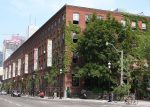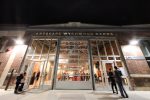This year’s theme for Doors Open—a public celebration of Toronto’s architecture from May 28 to 29—is “Re-used, Re-visited, Re-vised.” It is an apt theme for the times.
“I would say Toronto has become a showcase for adaptive reuse,” says Michael McClelland, a founding principal of ERA Architects, a firm long associated with the design model.
A short walk through downtown Toronto streets finds an historical gem or two here and there that have been repurposed or renovated for modern use. Prime examples are the iconic Maple Leaf Gardens, now home to Loblaws and an ice arena for Ryerson University, and the renovated 401 Richmond, an early 20th-century factory converted to one of the city’s arts/cultural hubs. Outside downtown, the Evergreen Brick Works and Wychwood Barns—now an arts and culture hub called Artscape—are among prominent makeovers.
See photo gallery below.
This year’s edition of Doors Open features more than 130 buildings, spanning 10 decades. The event will also feature 13 walking tours, sponsored for the first time by Carpenters Loc. 27 and Drywall Acoustic Lathing & Insulation Loc. 675. “It is a good (sponsorship) match for this event because when you look at the history of buildings in Toronto the union’s been involved in the construction of quite a lot of them,” says Kerri MacDonald, programing supervisor for the city of Toronto’s cultural events department, the Doors Open organizer.
Not long ago property owners steered clear of adapting historic buildings for modern usage. They were deemed risky ventures largely because of incalculable building costs.
Times have changed.
While there were only a handful of consultant teams qualified to take on the work a few decades ago, today there are plenty with proven track records, says McClelland, adding that the city “has developed a really good body of skilled tradespeople in conservation.”
McClelland points to the 19th-century Don Jail converted into offices for Bridgepoint Healthcare as a prime example of a complex adaptive reuse project. At one time the development was considered “too risky” to take on. “It was through really skilled trades that we were able to do the things we did there.”
The Dalton Company Ltd. is one of Toronto’s contractors active in the adaptive reuse movement. To its credit is work at The Distillery, a 19th-century complex reborn as a chic mixed-use hub, Toronto Botanical Gardens, and Wychwood Barns, now Artscape, which is the first LEED Heritage Gold building in Canada and one of the buildings in Doors Open.
“Twenty years ago, that building (Wychwood) might have been razed for a new development,” says Randy Dalton, president of the Dalton Company, which has been in business for 75 years. Wychwood was one of Dalton’s “most challenging projects,” he says, adding that renovating an old building for modern use is often more difficult than constructing a new building. “It is not cookie-cutter stuff that anyone with a toolbelt and a pair of hands can do. Most of the trades end up being union because the high skillset required demands it.”
He says training at the community college level and through Carpenters Loc. 27’s College of Carpenters and Allied Trades are examples of where to develop skilled trades that can take on the oft-complex renovations.
Eastern Construction’s president Frank DeCaria adds that there is no replacement for experience. “The craftsmen that built these buildings generations ago had honed their skills from years of experience. Today it is a matter of finding tradespeople that love what they do and want this type of career and then mentor them, train them […] empower them to be good tradesmen.”
Eastern Construction has been involved in a number of successful and award-winning adaptive reuse developments in Toronto. The Toronto Police Services 51 and 11 Divisions, Evergreen Brick Works, and the National Ballet School of Canada are three of many examples.
DeCaria says the Doors Open theme is a “good idea” because it broadens the public’s awareness of how older buildings can be repurposed, rather than demolished. And, he sees a bright future ahead for the movement in Toronto because the new generation of builders and designers “is more attuned to the three Rs (reduce, reuse, recycle) and sustainability.”
Communities, also, are more engaged in the design of their neighborhoods, which bodes well for integrating old into new buildings, he says, adding that “good leadership” is paramount to getting things done right.
Carpenters Loc. 27 has been a major player in the city’s building since it was established in 1882. “Members of earlier generations of our Local built many iconic buildings of Toronto such as Union Station, Maple Leaf Gardens, the Toronto Dominion Centre and much of our city’s infrastructure including the subway and Wychwood Barns,” says the Local’s president Mike Yorke.
“Now, later generations of our Local are re-using and revitalizing many of these buildings to be current today.”
McClelland sees a bright future for adaptive reuse projects in Toronto. “I think the next big challenge is Tower Renewal.” ERA is a consultant to the City of Toronto program aimed at retrofitting many of the city’s residential rental towers built from the 1950s-‘70s.
Open Doors organizer MacDonald says she came up with the Doors Open theme after noticing more old buildings being repurposed over the last few years. “This is a great city that is doing this kind of work a lot more now.”
She adds the theme is a tribute to Jane Jacobs — the famed author/activist who led a charge to preserve urban neighborhoods. She coined the phrase: new ideas need old buildings.
Don Procter is a writer with Carpenters Loc. 27.





















